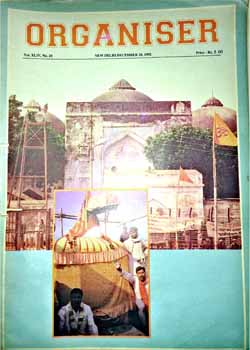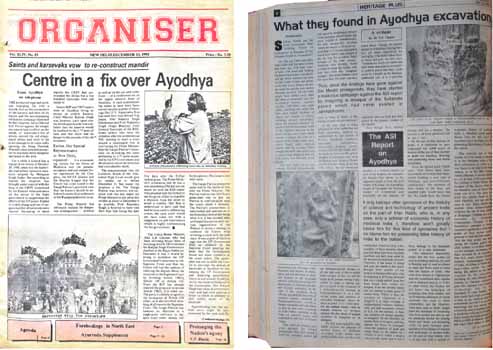
It was the lone voice of Organiser Weekly that was reverberating loudly when all the media houses were silent on Shri Ram Mandir issue. The weekly consistently reported the Ram Mandir Movement through its pages and played a constructive role in building the national discourse
Yatharth Sikka
After the Supreme Court verdict on the issue, we are bringing you a glimpse of our efforts to highlight the issue through our pages down the years.
On 7 April 1984, the Dharma Sansad was held for the first time in Delhi. The course of Ram Janmabhoomi was raised in this. Sri Ram Janmabhoomi Mukti Yagya Committee was formed under the chairmanship of Mahant Avedyanath, as decided by the Dharma Sansad resolution of free land of Sri Ram Janmabhoomi was taken on the banks of Saryu. The second Dharma Sansad was held in Udupi, Karnataka on 31 October 1985. It was announced that if the lock of Ram Janmabhoomi was not opened within the stipulated period, Saints will commit self-immolation. Dharma Sansad said that “it is unfortunate that even after 37 years of Independence, the birthplace of Lord Rama is still locked and we are not allowed to worship Shri Ram at the site. After this, on 1 February 1986, the lock of Ramjanmabhoomi was opened by order of the District Judge, Faizabad. The main motive of Dharma Sansad was not only the rebuilding of Ram Mandir but also to create a New Ayodhya ‘Ramrajya’.
After the peaceful ceremony of Dharma Sansad, ‘Ram Shila pujan’ was organised at Ayodhya in October, 1989. The Congress government did its best to stop the ceremony by posting securities but the VHP and Ramjanambhoomj committee went ahead with its plan. The government failed and climbed down. Shri Ashok Singhal said “that the laying of the foundation stone for the proposed temple to be magnificently rebuilt at the sacred birth place of Lord Ram has indeed marked the moment of nation’s invincible resolve to do away with the 450 years of stigma of foreign domination over one of the most hallowed symbol of national honour and freedom”. The was the most rejoicing moment as the Aarti progressed for over 40 minutes at the “Shilanyas Sthal.” This was one of the biggest achievements in the removal of disputed structure without its demolition to which people are not yet open.
After the success of Ramshila Pujan, it was now the turn of the Rath Yatra led by LK Advani from 25th September to 30th October 1990 to bring awareness among the people about Ram Janmabhoomi. The Rath yatra was 10,000 km long from Somnath to Ayodhya making it one of the most memorable events of expression which was a roaring success and a sea of humanity used by Hindu’s. Speaking at Nangloi, Advani said that “he had seen many governments being formed but never in the 40 years of my political life I have seen such was popular support for an issue.” With hand in hand Vishva Hindu Parishad was ahead with Karseva. Massive VHP activists were carried out throughout the country with the support from Bharatiya Janata party. 10,000 Karsevaks managed to reach Ayodhya around 30,000 security personnel were deployed in Ayodhya. On the order of Mulayam Singh security persons fired on the crowd and many car Sevaks were killed, Shri Ashok Singhal ji was also hit on the head by armed police.
To clear all the doubts whether the disputed structure was originally a Mandir or a Masjid, an excavation was ordered in July 1992. Eminent archaeologists including former ASI directors, Dr. Y.D. Sharma and Dr. K.M. Srivastava were given the course to evaluate and examine the findings. These findings included religious sculptures and a statue of Vishnu. They said that the inner boundary of the disputed structure may have belonged to an earlier temple imaging like Shiv-Parvati . The team found that the objects were ranging from the 10th through the 12th century. These objects included a number of amakalas, wheel type architectural element which is a Hindu mythology Symbol. Moreover this is a characteristic feature of all north Indian temples of the early medieval period. There was other evidence such as pillar, mouldings, door, floral patterns leaving an extra doubt regarding the existence of a 10th-12th century temple at the site of Ayodhya.

When it was Crystal clear that the disputed structure was earlier a temple and the Hindus started to realize that the government is not accepting them, they are only paying attention to a particular section and want to do politics on religion. For the many years Hindus were made fool in their own country seculars have been telling Hindus that they will reconstruct Ram Mandir. Hindus have suffered a lot, not once, thousands of times there temples have been demolished and Masjids have been built, but when the water flowed above the head, they have not listened to the government and the police and laid the unofficial foundation to build the Ram Mandir by demolishing disputed structure on 6th December 1992. The Hindus swear that day that they will build Temple in Ayodhya because independence is incomplete without Ram Mandir but the case was still there only movement was of time.
The Archaeological Survey of India (ASI) excavated the Ram Janambhoomi site again after 10 years at the direction of the Lucknow Bench of the Allahabad High Court, Uttar Pradesh in 2003. According to the Archaeological Survey of India, the human occupation began at the Ramjanambhoomi on the bank of river Saryu around 1200 BC and area belongs to the medieval time. Dr. Y.D.Sharma said that Ram‘s birthplace is now marked by a Masjid erected by the Mughal emperor Babar on the site of an earlier temple. This was the most clinching evidence that a Masjid was constructed on Ram Mandir and the material used in the construction belong to the Mandir founded in the form of wheel structure, Hindu God images, doors, floral patterns in the ruins of disputed structure.
The excavation ordered by the court provided more archaeological evidence of the Ram Mandir that existed at the disputed site and strengthened the Hindu claim over the land.














Comments